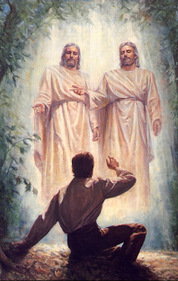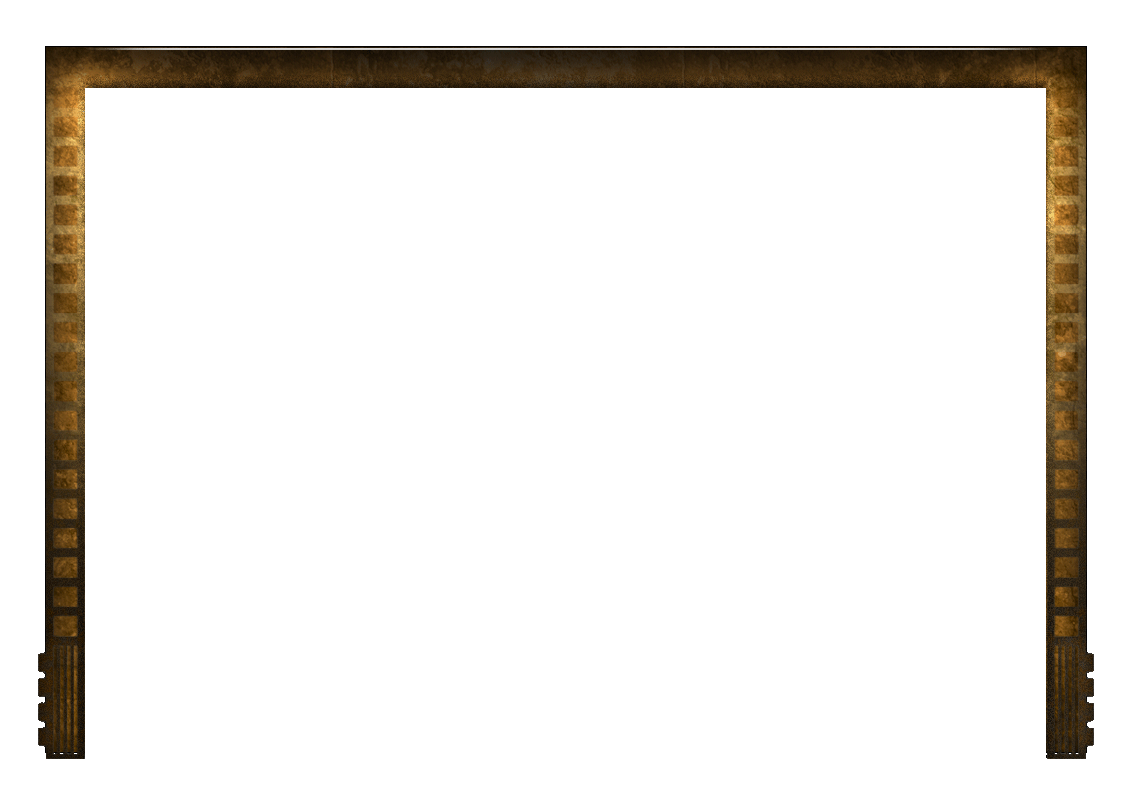Journey of Faith tracks the journey started in 600 bc by the Israelite Prophet Lehi and his family as they made their exodus from Jerusalem across the Arabian desert to the coast, and there to the New World. Lehi’s son, Nephi, begins the account in 600 bc, preserving it by engraving on metal plates. But by the very nature of their voyage to the Americas, the narrative did not come to light until the 1820s when by divine revelation Joseph Smith was directed to the plates and unearthed them from a hill in upstate New York.
That revelation to Joseph Smith was not the first he received. To follow the real beginning of this tale, we must go back to 1820 and the religious revival that was taking place in the Palmyra/Manchester area of New York.
 Joseph Smith’s family consisted of his father Joseph Sr., mother Lucy Mack, Joseph Jr., his four brothers and three sisters. They moved first to Palmyra and then a couple of miles south to Manchester where Joseph Sr. had a farm.[1] Upstate New York was the scene of camp and revival meetings during this period of time called the Second Great Awakening. It was known as the “Burned-over district” because of the many different revivals that occurred there. The Smith family was, to a certain extent, caught up in that fervor with some of the family aligned with the Presbyterians and others looking toward the Methodists and Baptists (JS—H 1:7–9).
Joseph Smith’s family consisted of his father Joseph Sr., mother Lucy Mack, Joseph Jr., his four brothers and three sisters. They moved first to Palmyra and then a couple of miles south to Manchester where Joseph Sr. had a farm.[1] Upstate New York was the scene of camp and revival meetings during this period of time called the Second Great Awakening. It was known as the “Burned-over district” because of the many different revivals that occurred there. The Smith family was, to a certain extent, caught up in that fervor with some of the family aligned with the Presbyterians and others looking toward the Methodists and Baptists (JS—H 1:7–9).
If they were at all literate, every family of that time had a Bible, usually the King James Version. The Smith family regularly read the Bible together and on their own.[2] So it might not be thought unusual for young Joseph, fourteen years old in the Spring of 1820, to be seeking clarification from the Bible on all the varied religious ideas he was getting from the revivals and camp meetings. In his own words:
In the midst of this war of words and tumult of opinions, I often said to myself: What is to be done? Who of all these parties are right; or, are they all wrong together? If any one of them be right, which is it, and how shall I know it? While I was laboring under the extreme difficulties caused by the contests of these parties of religionists, I was one day reading the Epistle of James, first chapter and fifth verse, which reads: If any of you lack wisdom, let him ask of God, that giveth to all men liberally, and upbraideth not; and it shall be given him. Never did any passage of scripture come with more power to the heart of man than this did at this time to mine. It seemed to enter with great force into every feeling of my heart. I reflected on it again and again, knowing that if any person needed wisdom from God, I did; for how to act I did not know, and unless I could get more wisdom than I then had, I would never know; for the teachers of religion of the different sects understood the same passages of scripture so differently as to destroy all confidence in settling the question by an appeal to the Bible. At length I came to the conclusion that I must either remain in darkness and confusion, or else I must do as James directs, that is, ask of God. I at length came to the determination to “ask of God,” concluding that if he gave wisdom to them that lacked wisdom, and would give liberally, and not upbraid, I might venture. (JS—H 1:10–13)
This is a very mature outlook for a fourteen-year old by today’s standards, but life in the fledgling country was harsh—no time for youthful leisure. Nevertheless, in a time when it was the norm to repeat formulaic prayers, the impetus to communicate directly with God could itself surely be thought of as responding to spiritual guidance. Joseph himself explained that he “had never as yet made the attempt to pray vocally” (JS—H1:14).
Accordingly, Joseph found himself on an early spring day in 1820 in the woods at the western boundaries of his father’s farm.[3] Joseph was called upon to tell this tale several times in his lifetime. And as with any recounting of a historical event, the complete experience was not contained in any of the recorded retellings. However, several elements are common and are incorporated into the canon of Latter-day Saint scripture.[4]
The first thing that happened as Joseph began to pray vocally for the first time was that he was immediately “seized upon by some power which entirely overcame me, and had such an astonishing influence over me as to bind my tongue so that I could not speak. Thick darkness gathered around me, and it seemed to me for a time as if I were doomed to sudden destruction” (JS—H 1:15). Describing this palpable, evil presence as the “enemy,” Joseph sought deliverance: “
But, exerting all my powers to call upon God to deliver me out of the power of this enemy which had seized upon me, and at the very moment when I was ready to sink into despair and abandon myself to destruction—not to an imaginary ruin, but to the power of some actual being from the unseen world, who had such marvelous power as I had never before felt in any being—just at this moment of great alarm, I saw a pillar of light exactly over my head, above the brightness of the sun, which descended gradually until it fell upon me. It no sooner appeared than I found myself delivered from the enemy which held me bound. (JS—H 1:16–17)
What happened next was to shatter the contemporary concept of God being a Trinity, a three-in-one. Here is Joseph again: “When the light rested upon me I saw two Personages, whose brightness and glory defy all description, standing above me in the air. One of them spake unto me, calling me by name and said, pointing to the other—This is My Beloved Son. Hear Him!” (JS—H 1:17). Joseph saw two “Personages,” God the Father and His Son Jesus Christ, separate in body and spirit. As the Father witnessed to the divinity of His Son when Jesus was baptized (Matt. 3:17) ) and on the Mount of Transfiguration (Luke 9:35), so too did He witness to Joseph that Jesus was His Beloved Son and that Joseph was to “hear” Him, with the full connotation of listening and obeying. Important to note, also, is that both the Father and the Son talked directly to Joseph.
No doubt much was revealed in that conversation, and no doubt Joseph was forbidden to record all of it, but it set the course of the young Joseph that in a few years led him restore the Primitive Church of Jesus Christ, later to be called The Church of Jesus Christ of Latter-day Saints.
My object in going to inquire of the Lord was to know which of all the sects was right, that I might know which to join. No sooner, therefore, did I get possession of myself, so as to be able to speak, than I asked the Personages who stood above me in the light, which of all the sects was right (for at this time it had never entered into my heart that all were wrong)—and which I should join. I was answered that I must join none of them, for they were all wrong; and the Personage who addressed me said that all their creeds were an abomination in his sight; that those professors were all corrupt; that: “they draw near to me with their lips, but their hearts are far from me, they teach for doctrines the commandments of men, having a form of godliness, but they deny the power thereof.” He again forbade me to join with any of them; and many other things did he say unto me, which I cannot write at this time. (JS—H 1:18–20).
But importantly for our story, later heavenly visitations led Joseph to unearth the plates, translate them, again by divine power, and bring forth to the world the Book of Mormon: Another Testament of Jesus Christ.
[1] Joseph Smith—History 1:4 (hereafter JS—H). More on the events in Palmyra and Manchester New York.
[2] Mark L. McConkie, The Father of the Prophet: Stories and Insights from the Life of Joseph Smith, Sr (1993), 11.
[3] josephsmith.net.
[4] For a comparison of the various recorded accounts, see Kent P. Jackson, “The First Vision,” in From Apostasy to Revelation, ed. Kent P. Jackson (Salt Lake City: Deseret Book, 1996), 66–79.

